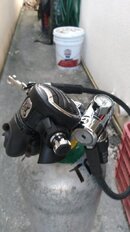- Messages
- 238
- Reaction score
- 293
- # of dives
- 200 - 499
There are certainly other threads with discussions about diving with transmitters on hoses in general or to prevent boat crew handling issues, but I'd like to hear others' thoughts and experiences with transmitters on tanks where you may be removing one or both tanks and traveling with them extended in caves or wrecks.
I have been using a direct downward angled transmitter connection for my cave dives as it seems many do, and I never worried about them taking much abuse. However, I recently completed restriction training and I am rethinking whether a hose provides a bit more “shock absorption” for when one or both tanks are removed and extended and they are more exposed to “incidental contact” in tight places or pushing them in little to no visibility.
I did speak with Richard from Divtronix (who does repair work for Shearwater) about the possible failure types and he felt that while it would be possible to cause an air loss situation after a significant blow to a direct connection, it was more likely that the transmitter would just stop working. His recommendation was to put them on short hoses, which is what I am thinking about doing.
My instructor is not adverse to transmitters, but he prefers SPGs, so didn’t have any real world experience..
For those that have reached this point before me, have you found a particular length that works better than others? Or, if you decided on a direct connect, what were your reasons?
Finally, any other protection tips?
Thanks!
I have been using a direct downward angled transmitter connection for my cave dives as it seems many do, and I never worried about them taking much abuse. However, I recently completed restriction training and I am rethinking whether a hose provides a bit more “shock absorption” for when one or both tanks are removed and extended and they are more exposed to “incidental contact” in tight places or pushing them in little to no visibility.
I did speak with Richard from Divtronix (who does repair work for Shearwater) about the possible failure types and he felt that while it would be possible to cause an air loss situation after a significant blow to a direct connection, it was more likely that the transmitter would just stop working. His recommendation was to put them on short hoses, which is what I am thinking about doing.
My instructor is not adverse to transmitters, but he prefers SPGs, so didn’t have any real world experience..
For those that have reached this point before me, have you found a particular length that works better than others? Or, if you decided on a direct connect, what were your reasons?
Finally, any other protection tips?
Thanks!




